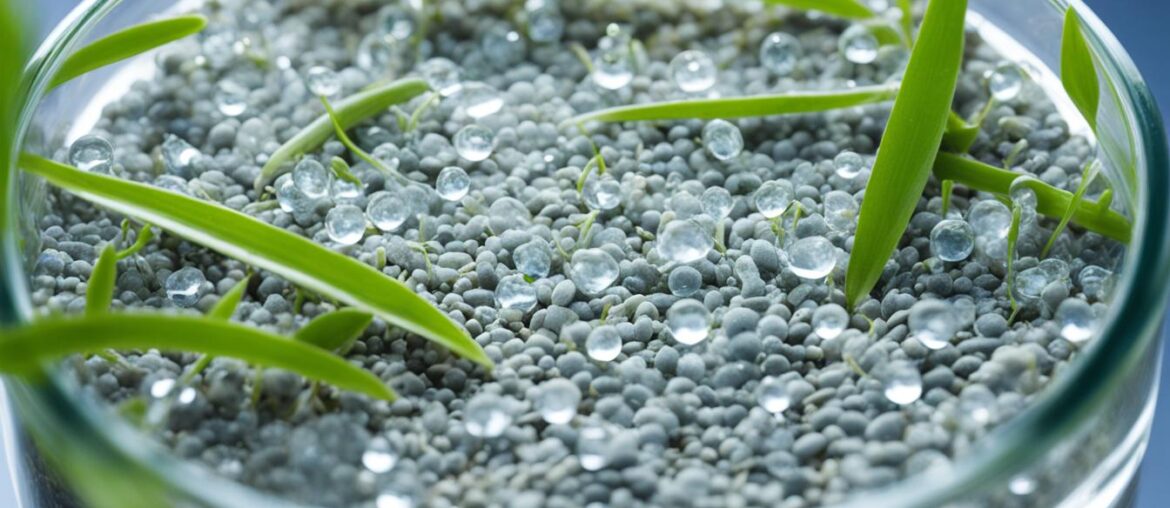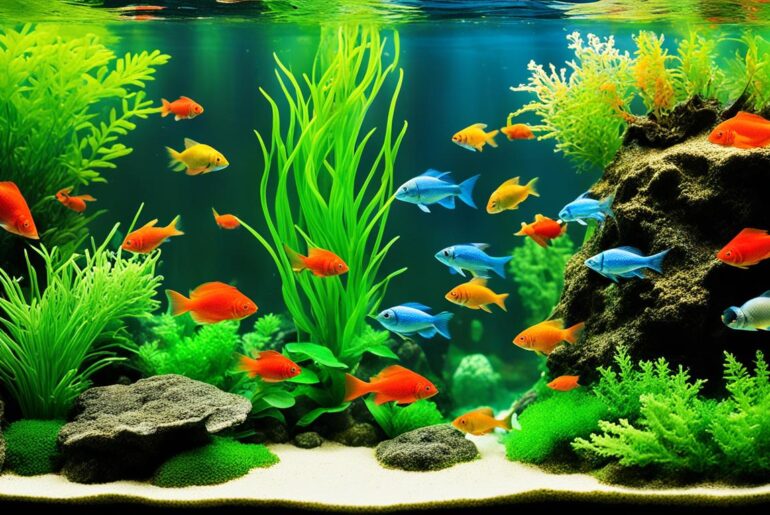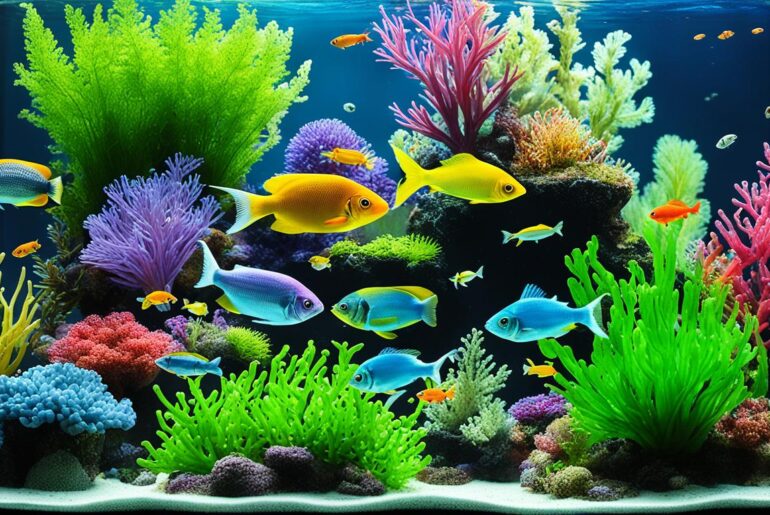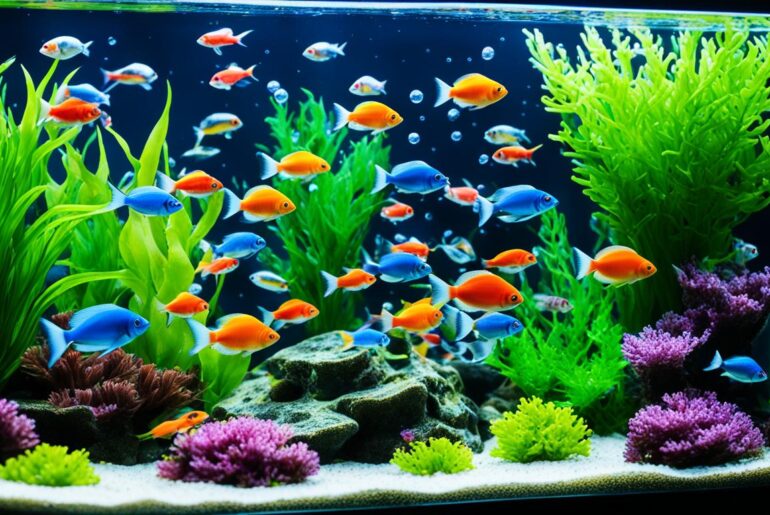Have you ever dreamed of having a stunning aquarium in your home, teeming with colorful fish and lush plants? I certainly did. The idea of creating a miniature aquatic world filled with life and beauty captivated me. However, I quickly learned that setting up an aquarium is not as simple as filling a tank with water and adding fish. It requires a delicate balance of chemistry, biology, and patience to create a thriving ecosystem for your aquatic pets.
When I first ventured into the world of aquarium keeping, I was overwhelmed by all the information and terminology surrounding aquarium cycling. Understanding the nitrogen cycle, beneficial bacteria, and the importance of establishing a stable ecosystem seemed like a daunting task.
But fear not! I’m here to guide you through the process and make it easier for you. In this article, we will explore the use of cycling additives during aquarium setup, demystify the nitrogen cycle, and delve into effective cycling techniques. Whether you’re a beginner or an experienced hobbyist, you’ll find valuable insights and practical tips to help you create a healthy and vibrant aquarium.
So, let’s dive in and discover how cycling additives can enhance your aquarium setup and provide a safe and thriving environment for your fish.
Key Takeaways:
- Using cycling additives can accelerate the aquarium cycling process and reduce the risk of high ammonia and nitrite levels.
- The nitrogen cycle is a natural process that converts and consumes nitrogen compounds through the activity of beneficial bacteria and plants.
- There are different methods of cycling your aquarium, such as fish-in cycling, cycling with plants, and fish-less cycling, each with its own benefits and considerations.
- Fish-in cycling involves gradually adding hardy fish to the tank, while cycling with plants utilizes live aquarium plants to absorb ammonia and nitrate.
- Fish-less cycling relies on an ammonia source to establish beneficial bacteria colonies, and cycling additives can be used to enhance the process.
Understanding the Aquarium Nitrogen Cycle
The nitrogen cycle is an essential process that occurs naturally in both the wild and in aquariums. It plays a vital role in maintaining a stable and healthy aquatic environment for your fish. Let’s dive deeper into the intricacies of the aquarium nitrogen cycle.
At the heart of the nitrogen cycle is the conversion and consumption of nitrogen compounds by beneficial bacteria and plants. The cycle begins when fish produce waste in the form of ammonia. This fish waste can quickly accumulate and become toxic if left unchecked.
Ammonia, the first component of the nitrogen cycle, needs to be broken down into less harmful substances. This is where beneficial bacteria come into play.
“Beneficial bacteria in the tank break down the ammonia into nitrite, which is still toxic to fish.”
These beneficial bacteria, known as nitrifying bacteria, convert ammonia into nitrite through a process called nitrification. Nitrite is also harmful to fish and can cause health issues if present in high concentrations.
The next stage of the nitrogen cycle involves the conversion of nitrite into nitrate, a compound that is less toxic to fish.
“Another group of bacteria, called nitrite-consuming bacteria, convert nitrite into nitrate.”
Nitrate levels can gradually increase in the aquarium over time. High levels of nitrate can still be harmful to fish, but they can be controlled through regular water changes or by incorporating plants that absorb nitrate as a nutrient.
Understanding the nitrogen cycle is vital for creating a stable and healthy aquarium environment.
Key Takeaways
- The nitrogen cycle is a natural process that converts and consumes nitrogen compounds in aquariums.
- Fish waste, in the form of ammonia, is broken down into nitrite by beneficial bacteria.
- Another group of bacteria converts nitrite into nitrate, a less toxic compound.
- Controlling nitrate levels is crucial for maintaining a healthy aquarium environment.
| Stage | Compounds | Key Players |
|---|---|---|
| Ammonia | Fish waste | Beneficial bacteria |
| Nitrite | Toxic byproduct of ammonia breakdown | Nitrifying bacteria |
| Nitrate | Less toxic compound | Nitrite-consuming bacteria/plants |
Methods of Cycling Your Aquarium
There are several methods you can use to cycle your aquarium, depending on your preferences and experience level.
Fish-in Cycling
Fish-in cycling involves adding a few hardy fish to the tank and gradually increasing their numbers while monitoring water parameters. This method allows you to observe the cycling process while introducing fish to the tank. It’s essential to choose fish that can tolerate high ammonia and nitrite levels during the initial stages of cycling. By closely monitoring the water quality and performing regular water changes, you can ensure a safe and healthy environment for your fish.
Cycling with Plants
If you prefer a more natural approach, cycling with plants is an excellent option. Adding live aquarium plants to your tank can accelerate the cycling process by naturally absorbing ammonia and nitrate. As the plants grow, they provide a beneficial environment for the growth of beneficial bacteria. By choosing suitable plant species, providing proper lighting, and monitoring plant care, you can create a beautiful and balanced ecosystem for your fish.
Fish-less Cycling
Fish-less cycling is a popular method that does not involve the use of live fish during the cycling process. Instead, this method relies on ammonia dosing to establish the necessary bacterial colonies. You can use fish food or ammonia-rich substances such as ammonium chloride as a source of ammonia. Daily monitoring of ammonia and nitrite levels is crucial during fish-less cycling. To reduce nitrate levels, large water changes are often performed. Once the cycling is complete, you can safely introduce fish to your aquarium.
Explore the table below for a quick comparison of the different cycling methods:
| Method | Advantages | Considerations |
|---|---|---|
| Fish-in Cycling | – Allows for fish observation and interaction – Can be faster than other methods |
– Requires careful monitoring of water parameters – Need to choose appropriate fish species |
| Cycling with Plants | – Creates a natural and visually appealing aquarium – Enhances water quality with plant filtration |
– Requires knowledge of plant care and maintenance – Choosing suitable plant species |
| Fish-less Cycling | – Avoids stress on fish during cycling – Control over ammonia dosing |
– Daily monitoring of ammonia and nitrite levels – Requires large water changes |
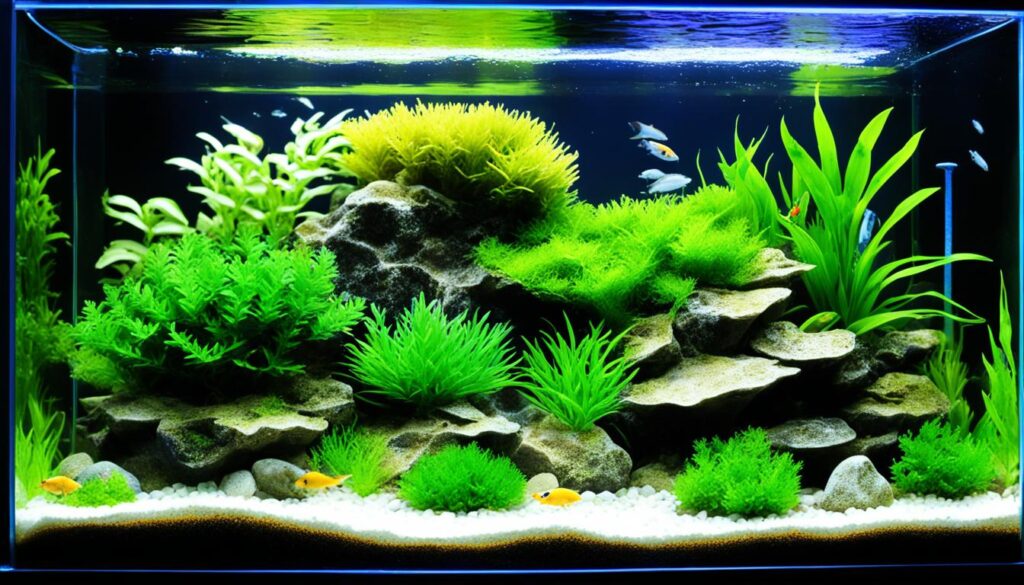
Once the cycling process is complete, and the water parameters are stable, you can start stocking your aquarium with the desired fish species. It’s important to research the compatibility and care requirements of different fish to ensure a harmonious and healthy community. Whether you choose fish-in cycling, cycling with plants, or fish-less cycling, patience and diligence in monitoring water parameters are key to establishing a thriving aquarium ecosystem.
Fish-In Cycling – A Beginner’s Approach
When it comes to setting up a new fish tank, fish-in cycling is a popular approach for beginners who prefer not to wait for several weeks or months before adding fish to their tank. This method allows you to start enjoying your aquarium sooner while still ensuring a healthy and stable environment for your fish.
To successfully implement fish-in cycling, it’s important to follow some key guidelines. Firstly, begin with a small number of hardy fish that can withstand the initial fluctuations in water parameters. This gradual fish addition helps the beneficial bacteria in your tank to grow and establish a stable ecosystem.
Feeding your fish during the cycling process requires careful attention. Start by feeding them lightly, as the bacterial colonies are still developing and may not be able to handle a heavy waste load. As the beneficial bacteria grow, gradually increase the amount of food provided to your fish.
To accelerate the cycling process and promote the growth of beneficial bacteria, consider seeding your tank with bacteria from an established tank. This can be done by transferring filter media or decorations from a mature aquarium to your new tank. Alternatively, you can use live nitrifying bacteria supplements, which provide a concentrated dose of beneficial bacteria.
Throughout the fish-in cycling process, it’s essential to monitor water quality to ensure the well-being of your fish. Regularly test the ammonia and nitrite levels using ammonia test strips and multi-test strips. Aim to keep ammonia and nitrite levels within safe ranges to minimize stress on your fish.
By following these guidelines and keeping a close eye on water quality, you can establish a healthy and thriving aquarium through fish-in cycling. Remember, patience is key as the beneficial bacteria need time to establish and create a balanced ecosystem. Soon enough, you’ll have a beautiful aquarium filled with happy and contented fish.
Cycling with Plants – Creating a Natural Ecosystem
Cycling with plants is a popular method that not only enhances the aesthetics of your aquarium but also plays a vital role in creating a natural and balanced ecosystem. Live aquarium plants offer numerous benefits, including the absorption of ammonia and nitrate, which effectively reduces their levels in the water. This helps maintain a healthy environment for your fish.
To successfully cycle with plants, it’s essential to choose suitable species that thrive in an aquatic environment. Make sure to provide proper lighting, substrate, and fertilizers to support their growth. Regular plant care and monitoring their progress are vital for successful cycling.
As the plants grow and show new growth, it indicates that the cycling process is complete. However, it’s important to note that even with healthy plant growth, water testing is still necessary to ensure that ammonia and nitrite levels are at 0 ppm and nitrate levels are below 40 ppm before adding fish to your aquarium.
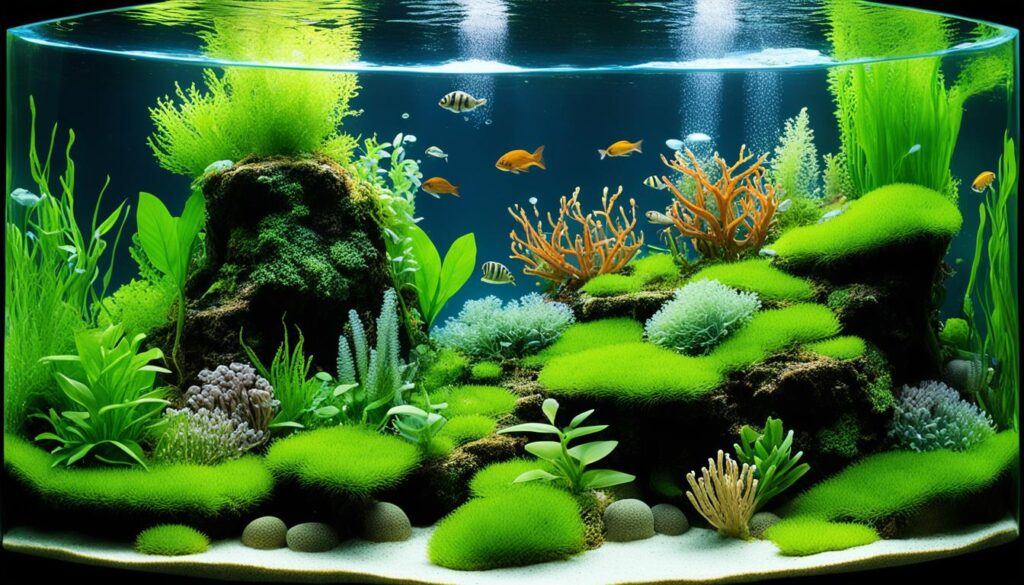
Benefits of Cycling with Plants
- Ammonia and Nitrate Absorption: Live aquarium plants absorb ammonia and nitrate, reducing their levels in the water and creating a healthier environment for fish.
- Improved Water Quality: Aquatic plants contribute to the breakdown of waste compounds and help deter the growth of algae, resulting in improved water quality.
- Natural and Visually Appealing Environment: The presence of live plants adds natural beauty to your aquarium, creating an aesthetically pleasing environment for both you and your fish.
- Enhanced Oxygenation: Aquatic plants continuously release oxygen into the water through photosynthesis, promoting better oxygenation for fish and other inhabitants.
- Stabilizes pH and Reduces Algae Growth: Live plants can help stabilize pH levels in the aquarium, reducing fluctuations that can be harmful to fish. Additionally, their presence helps inhibit excessive algae growth.
Cycling with plants is a rewarding method that not only aids in establishing a balanced ecosystem but also provides numerous benefits for your aquarium’s overall health and beauty.
Fish-Less Cycling – Building Bacteria Colonies
When it comes to cycling your aquarium, there’s a method that doesn’t involve the use of live fish. It’s called fish-less cycling, and it relies on an ammonia source to establish the necessary bacterial colonies. This approach is ideal for those who prefer to avoid the potential stress on fish during the cycling process.
To kickstart fish-less cycling, you’ll need an ammonia source. Many aquarists use fish food, while others prefer ammonia-rich substances like ammonium chloride. These provide the necessary ammonia for bacterial growth, allowing the beneficial bacteria in your tank to establish themselves.
Throughout the cycling process, it’s crucial to regularly test the water for ammonia and nitrite levels. This will help you monitor the progress of bacterial colonization and ensure that the conditions in your tank are suitable for the next steps.
Additionally, it’s important to use a water conditioner when preparing water for your aquarium. This eliminates harmful chlorine and chloramine that can be toxic to fish and beneficial bacteria.
Remember, fish-less cycling requires patience. It can take several weeks for the beneficial bacterial colonies to fully establish themselves. But once the process is complete, you can move on to the exciting part: stocking your aquarium with your favorite fish species!
Tips for Successful Fish-Less Cycling
- Choose a reliable ammonia source such as fish food or ammonium chloride.
- Monitor ammonia and nitrite levels regularly using a reliable water testing kit.
- Use a water conditioner to remove chlorine and chloramine from tap water.
- Be patient and allow several weeks for the bacterial colonies to establish.
- Once the cycling is complete, you can safely introduce fish to your aquarium.
By following these steps and closely monitoring water parameters, you can successfully cycle your aquarium, establish a healthy bacterial colony, and create a thriving environment for your fish.
| Advantages of Fish-Less Cycling | Benefits |
|---|---|
| Promotes the growth of beneficial bacteria | Establishes a stable nitrogen cycle |
| Reduces stress on fish | Creates a safe environment for stocking fish |
| Allows for precise control over ammonia levels | Minimizes the risk of ammonia and nitrite spikes |
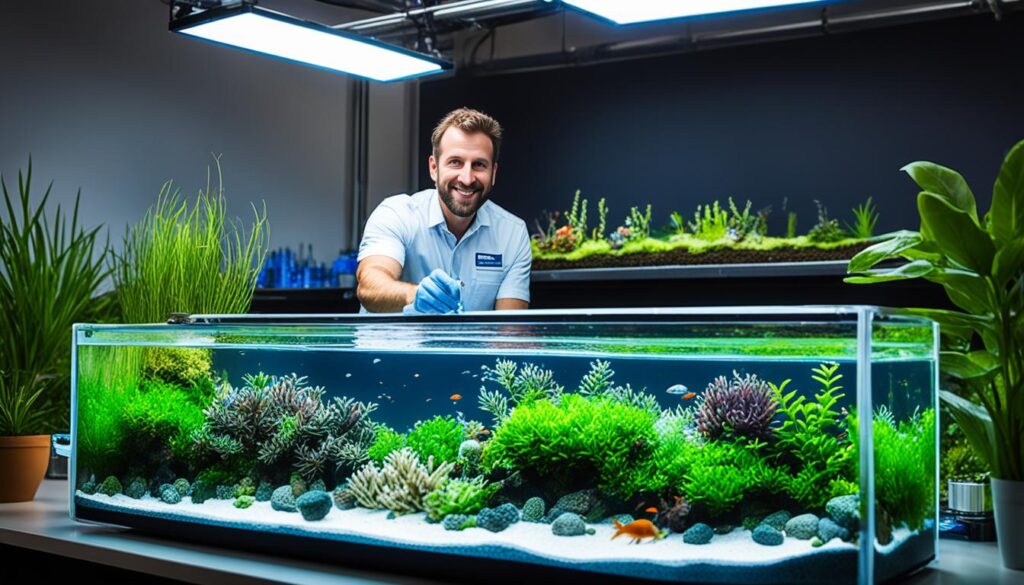
Using Cycling Additives – Accelerating the Process
Cycling additives are essential tools for expediting the aquarium cycling process and establishing a healthy ecosystem. These additives, including aquarium supplements, nitrifying bacteria, and bacterial boosters, provide a range of benefits that contribute to the success of your aquarium setup.
By introducing live nitrifying bacteria supplements, you can jumpstart the development of beneficial bacterial colonies that convert ammonia into less harmful compounds. These bacteria play a crucial role in maintaining optimal water conditions and preventing ammonia and nitrite spikes.
In addition to live bacteria, cycling additives may also include water conditioners enriched with ammonia-control compounds. These conditioners help regulate the levels of ammonia, creating a safe and stable environment for your fish. The controlled conversion of ammonia and nitrites is crucial for the health and well-being of your aquatic inhabitants.
Utilizing cycling additives not only accelerates the cycling process but also enhances water quality. By promoting the growth of beneficial microorganisms, these additives establish a balanced ecosystem that reduces the risk of harmful substances accumulating in the water. As a result, your aquarium will be more resilient to fluctuations and maintain a healthier environment for your fish.
When selecting cycling additives, it is important to choose products from reputable brands that are known to provide high-quality formulations. Look for additives that specifically mention their ability to support the cycling process and promote beneficial bacteria growth.
| Cycling Additives | Benefits |
|---|---|
| Live nitrifying bacteria supplements | Stimulates the growth of beneficial bacteria colonies |
| Bacterial boosters | Enhances the efficiency of ammonia and nitrite conversion |
| Ammonia-control water conditioners | Regulates ammonia levels, creating a safe habitat for fish |
Using cycling additives is a valuable strategy for aquarists who seek to establish a thriving aquarium quickly and efficiently. These products provide the necessary boost to the natural cycling process, ensuring a well-balanced environment and healthier fish. Selecting the right cycling additives can significantly improve the success of your aquarium setup.
Benefits of Using Cycling Products
Using cycling products during aquarium setup offers numerous advantages. Firstly, these products can expedite the cycling process, allowing you to add fish to the tank sooner. By introducing essential bacteria, cycling additives help establish a stable bacterial colony, reducing the risk of ammonia and nitrite spikes that can harm fish. This not only promotes a faster cycling process but also creates a healthier environment for your aquatic friends.
Cycling additives play a vital role in maintaining low ammonia and nitrite levels, which are crucial for fish health. By providing a favorable environment with controlled levels of these harmful compounds, cycling products contribute to the overall well-being of your fish. They minimize stress and the risk of diseases associated with high ammonia and nitrite levels, ensuring that your fish can thrive in their new habitat.
Another benefit of using cycling additives is the improvement of water quality. These products help break down harmful waste compounds and deter the growth of algae, resulting in cleaner and clearer water. The breakdown of waste by beneficial bacteria also reduces the need for frequent and large water changes, providing a more stable ecosystem for your fish.
Incorporating cycling additives into your aquarium setup routine can significantly enhance the success of your fishkeeping venture. With faster cycling, reduced ammonia and nitrite spikes, healthier fish, and improved water quality, you can create a thriving aquarium that brings joy and beauty to your home.
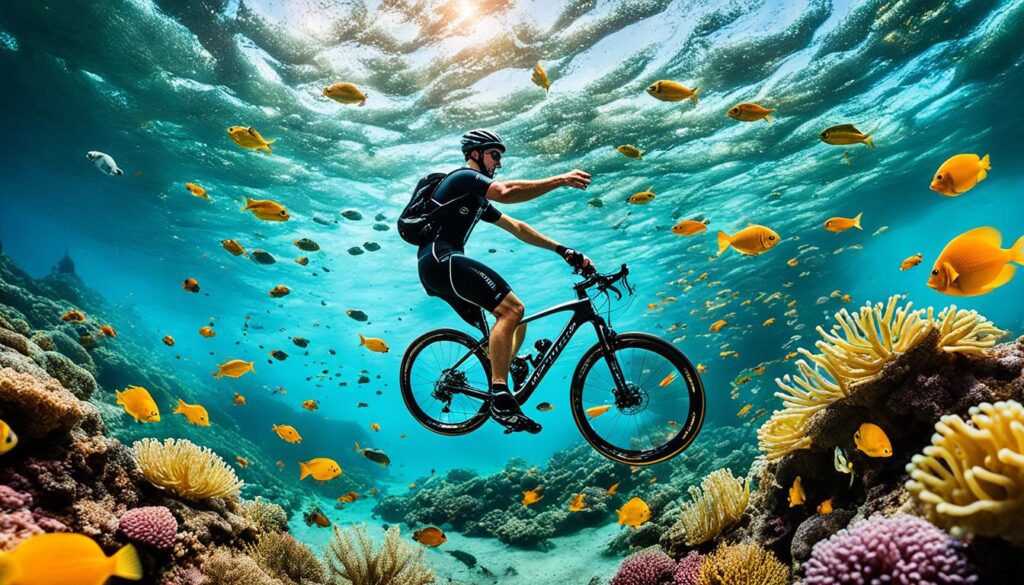
Expert Tip:
“To ensure the effectiveness of cycling products, always follow the instructions provided by the manufacturer. Use the recommended dosage and monitor your water parameters regularly to ensure optimal conditions for your fish.”
Effective Cycling Techniques for Aquariums
To ensure successful cycling, it’s important to follow effective techniques and best practices. By implementing these strategies, you can create a healthy and stable environment for your fish. Here are some key practices to consider:
1. Monitoring Water Parameters
Regularly measuring water parameters such as ammonia, nitrite, and nitrate levels is crucial for tracking the progress of the cycling process. Use reliable test kits to obtain accurate readings and identify any potential imbalances.
2. Regular Water Changes
Performing regular water changes is essential for maintaining water quality and keeping ammonia and nitrite levels in check. Consider changing approximately 10-20% of the water in your tank every 1-2 weeks, or as needed based on your specific water parameters.
3. Gradual Fish Introduction
When introducing fish to your newly cycled aquarium, it’s best to do so gradually. By adding a few fish at a time, you allow the bacterial colony to adjust to the increased waste load, minimizing stress and the risk of ammonia and nitrite spikes.
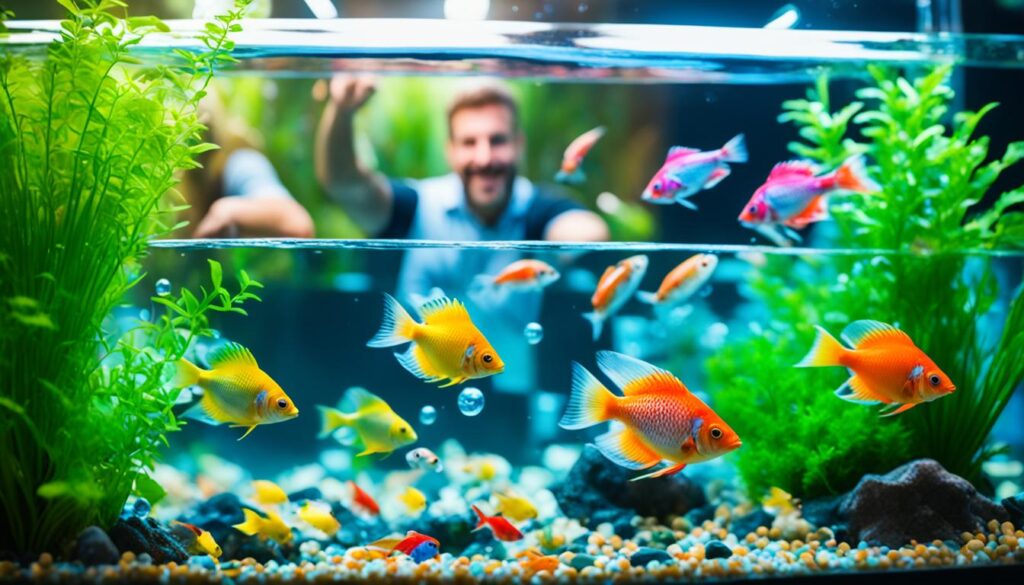
Remember, patience is key when cycling your aquarium. Take your time and allow the beneficial bacteria to establish a healthy and stable environment for your fish.
By practicing these effective cycling techniques and maintaining proper aquarium care, you can ensure the well-being of your fish and create an optimal habitat for them to thrive. Happy cycling!
| Technique | Description |
|---|---|
| Monitoring Water Parameters | Regularly test ammonia, nitrite, and nitrate levels to track the progress of the cycling process and address any imbalances. |
| Regular Water Changes | Perform routine water changes to maintain water quality and prevent the buildup of harmful compounds. |
| Gradual Fish Introduction | Add fish to your aquarium slowly to allow the bacterial colony to adjust to the waste load and reduce stress on the fish. |
Maintaining a Healthy Aquarium
Once your aquarium has completed the cycling process, it’s crucial to prioritize regular maintenance to ensure a healthy and thriving aquatic ecosystem. By following proper care practices, you can maintain optimal water conditions, promote the well-being of your fish, and prevent potential issues.
Regular Water Testing
Regularly testing the water parameters of your aquarium is essential for maintaining a healthy environment. Monitor levels of ammonia, nitrite, and nitrate to ensure they stay within safe ranges. This will help you identify any imbalances or potential problems that may arise.
Performing Water Changes
Water changes play a vital role in maintaining water quality and reducing the accumulation of nitrate in your aquarium. Regularly schedule and perform water changes as needed to remove built-up waste products and replenish fresh and clean water.
Proper Fish Feeding
Feeding your fish a balanced and appropriate diet is crucial for their overall health and well-being. Make sure to provide them with the right amount and types of food that suit their dietary requirements. Overfeeding can lead to excess waste and water quality issues.
Monitoring Fish Behavior
Keep a close eye on your fish’s behavior and appearance. Any changes in behavior, such as lethargy, loss of appetite, or abnormal swimming patterns, can be an indication of potential health problems. Promptly addressing these issues can prevent further complications.
Regular Filter Maintenance
Maintaining your filtration system is paramount for ensuring optimal water conditions. Regularly clean and replace the filter media to keep it functioning effectively. A well-maintained filter will help remove waste, toxins, and impurities from the water, promoting a healthy aquatic environment.
Incorporating these maintenance practices into your aquarium care routine will help you create a thriving and enjoyable home for your fish. Remember, a healthy aquarium requires consistent attention and care to ensure the well-being of its inhabitants.

| Maintenance Task | Frequency |
|---|---|
| Water Testing | Weekly |
| Water Changes | Every 1-2 weeks, depending on the aquarium size |
| Fish Feeding | 2-3 times a day, in appropriate quantities |
| Monitoring Fish Behavior | Daily |
| Filter Maintenance | Monthly |
By following the suggested maintenance schedule, you can ensure a well-maintained aquarium that provides a healthy and vibrant habitat for your fish.
Conclusion
Creating a healthy and thriving environment for your fish begins with proper aquarium setup and cycling. By following effective techniques and incorporating cycling additives, you can establish a balanced ecosystem that promotes the overall well-being of your fish. Maintaining optimal water conditions and reducing the risk of ammonia and nitrite spikes is crucial for their health and longevity.
Remember to regularly test the water parameters using reliable test kits to ensure that ammonia, nitrite, and nitrate levels are within safe ranges. Additionally, maintaining proper aquarium care, such as performing regular water changes and monitoring fish behavior, is essential for their well-being.
With the right approach, cycling your aquarium and using additives can lead to a vibrant and flourishing aquatic habitat. By prioritizing the health of your fish and providing optimal water conditions, you can enjoy a beautiful and thriving aquarium for years to come.
FAQ
What is aquarium cycling?
Aquarium cycling is the process of establishing a balanced ecosystem in a new fish tank to create a safe environment for fish. It involves the conversion and consumption of nitrogen compounds by beneficial bacteria and plants, known as the nitrogen cycle.
How does the nitrogen cycle work in an aquarium?
The nitrogen cycle starts when fish produce waste, or ammonia. Beneficial bacteria in the tank break down the ammonia into nitrite, which is still toxic to fish. Another group of bacteria then convert the nitrite into nitrate, which is less harmful to fish and can be removed from the water through water changes or absorbed by plants.
What are the different methods of cycling an aquarium?
There are three main methods: fish-in cycling, cycling with plants, and fish-less cycling. Fish-in cycling involves gradually adding hardy fish and monitoring water parameters. Cycling with plants uses live aquarium plants to absorb ammonia and nitrate. Fish-less cycling uses ammonia dosing to establish bacterial colonies without live fish.
How does fish-in cycling work?
Fish-in cycling is a method where a small number of hardy fish are added to the tank, and their numbers are gradually increased over time. The key is to start with a few fish and feed them lightly, gradually increasing the amount of food as beneficial bacteria grow. It can be accelerated by seeding the tank with beneficial bacteria or using live nitrifying bacteria supplements.
How does cycling with plants help establish a healthy aquarium?
Cycling with plants involves adding live aquarium plants that naturally absorb ammonia and nitrate. These plants not only enhance the aesthetics of the tank but also accelerate the cycling process by reducing the levels of these compounds in the water. Choosing suitable plant species and providing proper care are important for successful cycling.
What is fish-less cycling?
Fish-less cycling is a method that does not involve the use of live fish. Instead, an ammonia source such as fish food or ammonium chloride is used to provide a food source for beneficial bacteria. Regular water testing and large water changes are necessary to maintain ammonia and nitrite levels within safe ranges. Once cycling is complete, the aquarium can be stocked with fish.
What are cycling additives and how do they help?
Cycling additives are products specifically designed to accelerate the aquarium cycling process by providing essential nitrifying bacteria and other beneficial microorganisms. These products help establish and maintain healthy bacterial colonies, ensuring efficient ammonia and nitrite conversion. They also promote a balanced ecosystem, improve water quality, and reduce the risk of ammonia and nitrite spikes.
What are the benefits of using cycling products during aquarium setup?
Using cycling products can expedite the cycling process, allowing for the faster addition of fish to the tank. They help establish a stable bacterial colony, reducing the risk of ammonia and nitrite spikes that can harm fish. Cycling additives also contribute to healthier fish by creating a favorable environment with low ammonia and nitrite levels. These products can also improve water quality by promoting the breakdown of waste compounds and deterring algae growth.
What are some effective cycling techniques for aquariums?
Effective cycling techniques include monitoring water parameters such as ammonia, nitrite, and nitrate levels using reliable test kits. Regular water changes help maintain water quality and control ammonia and nitrite levels. Gradual fish introduction allows the bacterial colony to adjust to the increased waste load. These techniques, along with proper aquarium care, contribute to the establishment of a healthy and stable environment.
How do I maintain a healthy aquarium after the cycling process?
Regular maintenance is crucial for a healthy aquarium. This includes regular water testing to monitor ammonia, nitrite, and nitrate levels. Water changes should be performed as needed to maintain water quality and reduce nitrate accumulation. Proper fish feeding based on their dietary requirements is important for their overall health. Monitoring fish behavior and appearance and regularly maintaining the filter are also essential for optimal water conditions.
